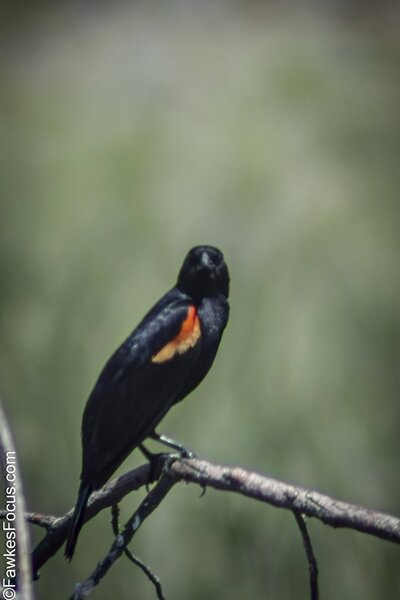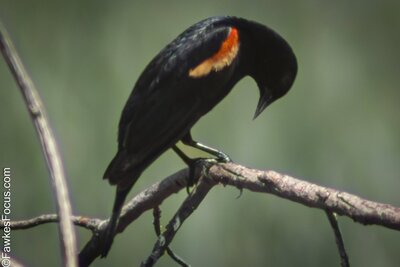Red Winged Blackbird: Identification and Facts
Searching for information on the Red-winged Blackbird? This guide will help you identify these birds by their distinctive red and yellow patches located on their shoulders, which are often hidden under body feathers except during displays, understand their behaviors, and explore their habitats and migration patterns. Highly adaptable, Red-winged Blackbirds are found in a variety of environments. Their widespread range includes Canada, Florida, and Mexico, illustrating their extensive distribution across North America. They are also found in most of North America and much of Central America, further emphasizing their adaptability. They frequently visit feeders, where they feed on seeds and insects, making them a common sight for backyard birdwatchers.
Table of Contents
ToggleRed-winged Blackbird Photos by Fawkes Focus
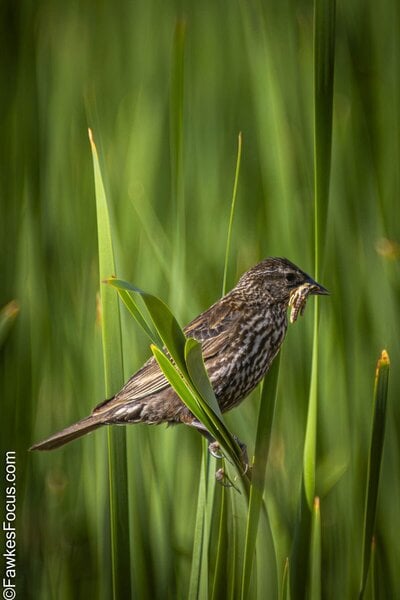
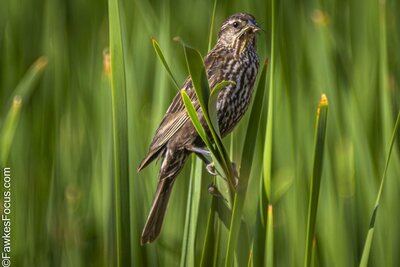
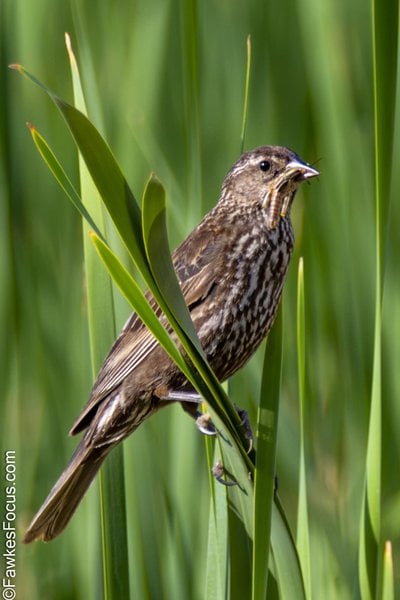
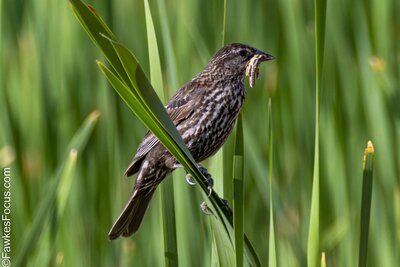
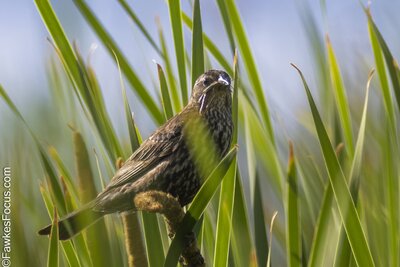
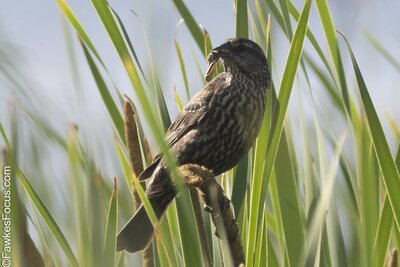
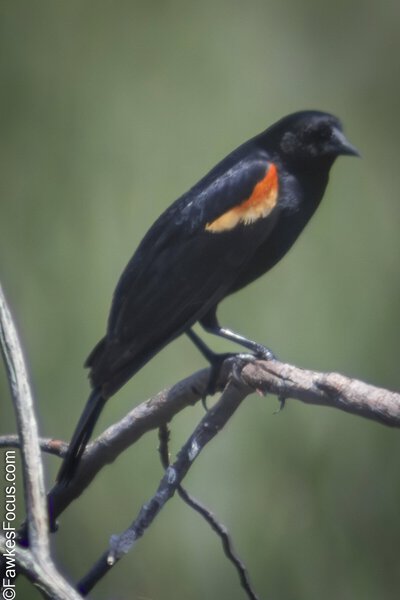
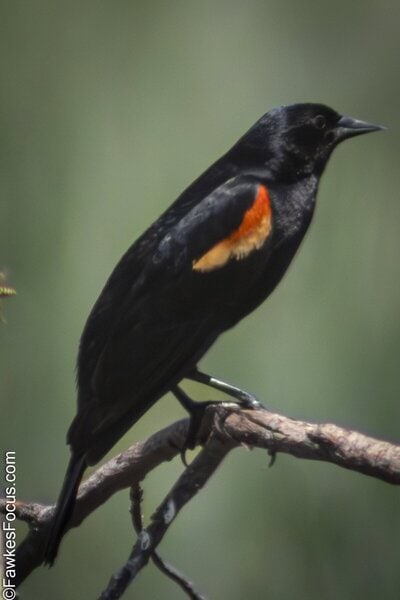
Introduction to the Species
The Red-winged Blackbird (Agelaius phoeniceus) is one of the most recognizable perching birds across North America, celebrated for its striking appearance and lively presence. This passerine bird, a member of the Icteridae family, is especially known for the male’s glossy black plumage adorned with bold red and yellow shoulder patches. These patches, or epaulets, are often accentuated when the male red-winged blackbird sings or defends its territory, making them a standout feature among large flocks or when perched alone. Interestingly, males can display their red shoulder patches or hide them depending on their confidence level.
Female red winged blackbirds, on the other hand, are more subtly colored, with streaky brown feathers that help them blend into their surroundings. Despite their more muted appearance, these birds are just as vital to the species’ success, especially during the nesting season. Red-winged Blackbirds are sexually dimorphic, with males being more vividly colored than females, a trait that plays a significant role in their mating and social behaviors.
Red-winged blackbirds are common sights in fields, marshes, and even suburban yards, particularly in the South during the winter months. Their adaptability allows them to thrive in a variety of habitats, and they are frequent visitors to feeders stocked with sunflower seeds, corn, peanut hearts, and other seed mixes. Whether you spot a male puffing up his shoulder patches or a flock feeding in your yard, these birds are a vibrant and familiar sign of the changing seasons throughout the year.
Key Takeaways
Red-winged blackbirds are easily identifiable by their size, shape, and distinct color patterns, with males featuring glossy black plumage and vibrant red and orange shoulder patches, while females have a more camouflaged appearance.
During the breeding season, male red-winged blackbirds exhibit aggressive territorial behavior, defending their nesting areas and engaging in elaborate courtship displays to attract females, while females are responsible for nest construction.
Although commonly found in wetlands, red-winged blackbirds are adaptable to various habitats and face threats such as habitat loss and climate change, necessitating conservation efforts to protect their populations.
Identifying Red Winged Blackbirds
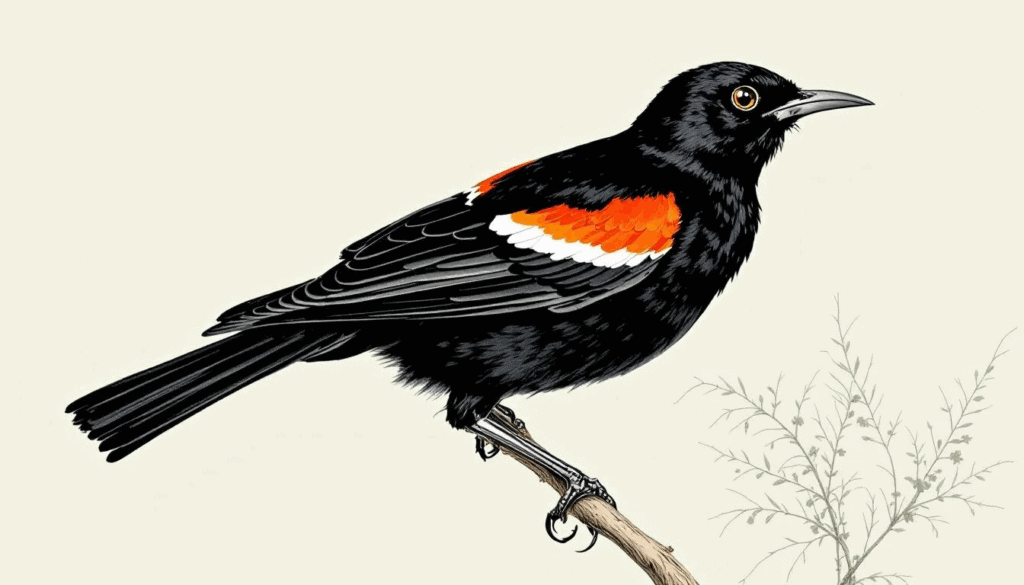
Identifying red-winged blackbirds can be an exhilarating experience, especially given their striking appearance and distinctive behaviors. Typically measuring between 6.7 to 9.1 inches in length with a wingspan of 12.6 to 15.4 inches, these birds are a sight to behold. Their morphology and size can vary across regions, reflecting adaptations to localized climatic conditions. Red-winged blackbirds are commonly found along the edges of marshes and fields, as well as coastal wetlands, where they breed and forage.
The male red-winged blackbird is difficult to mistake for any other species due to his unmistakable red and yellow shoulder patches and glossy black plumage.
Understanding two key identification markers – size and shape, and color patterns – will help you easily distinguish male and female red-winged blackbirds.
Size and Shape
Red-winged blackbirds typically have the following physical characteristics:
Length: 7 to 9 inches, placing them on the larger end of the spectrum for blackbirds
Wingspan: 12.2 to 15.8 inches, aiding their agility and quick movements during flight
Weight: 1.1 to 2.7 ounces, light enough to exhibit remarkable flight agility
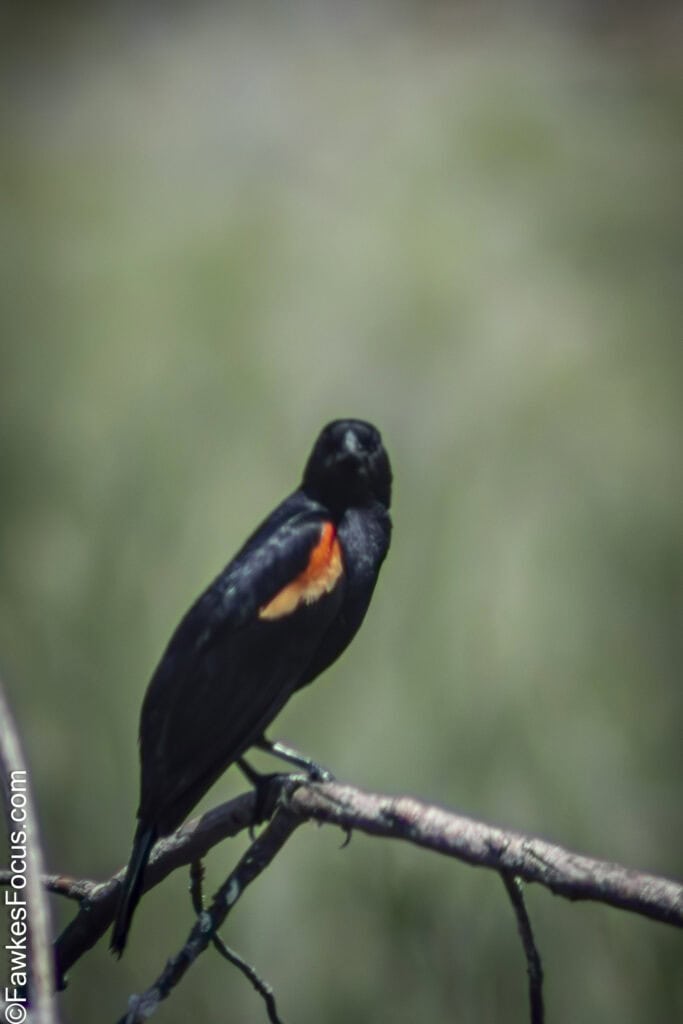
These birds feature a slightly rounded head and a sharply pointed bill, which they use adeptly for foraging. Owls have a body structure that supports their varied diet and habitat preferences, making them a versatile and adaptable species. Male Red-winged Blackbirds have a conical bill that is sharply pointed, aiding in their efficient foraging and feeding habits.
Color Pattern
One of the most striking features of male red-winged blackbirds is their glossy black plumage accented with red and orange shoulder patches. These vibrant red feathers are not just for show; they play a crucial role in territorial displays and courtship rituals. In contrast, female red-winged blackbirds sport a more subdued coloration, primarily dark brown with noticeable streaks.
The males’ red shoulder patches are visible both while resting and in flight, making them easily distinguishable. On the other hand, females’ streaky brown appearance helps them blend into their surroundings, providing essential camouflage while nesting.
Male vs Female Characteristics
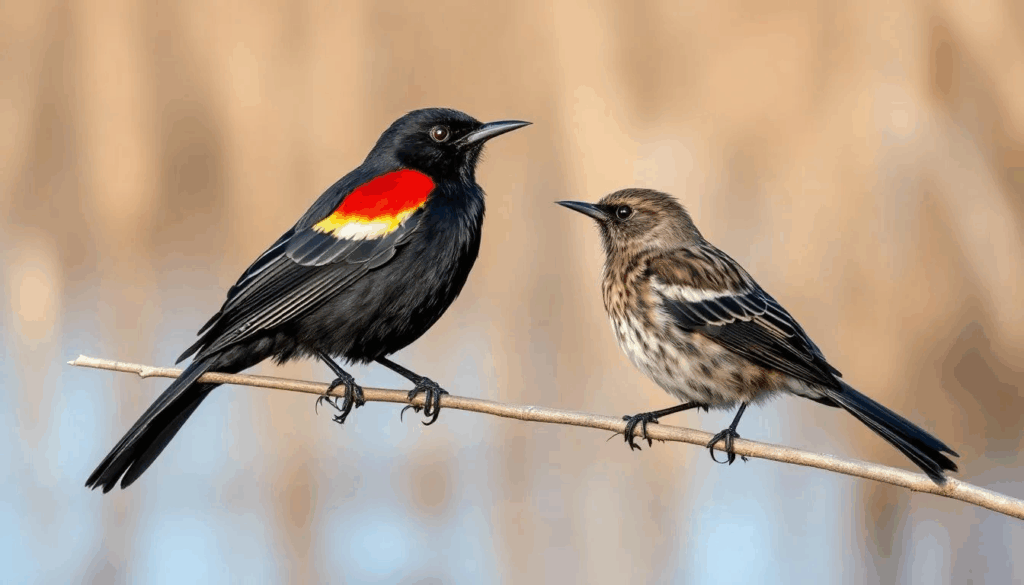
Male red-winged blackbirds are immediately recognizable by their glossy black feathers and distinctive red and yellow shoulder patches. These bright markings are not just for aesthetics; they serve to attract females and intimidate rival males. During courtship, males perform elaborate displays, sing to attract mates, and flaunt their vibrant wing patches.
In contrast, adult female red-winged blackbirds are less conspicuous, which helps them avoid predation, especially while nesting. Females are primarily dark brown with streaks, resembling large sparrows. This stark difference in appearance between the sexes is a fascinating aspect of the species’ biology, reflecting their differing roles and behaviors. Most chicks within a territory are sired by the dominant male, though some may be sired by less dominant males that manage to sneak in.
Behavior and Social Structure
Red-winged blackbirds exhibit a complex social structure and a variety of behaviors that keep birdwatchers intrigued. Key behaviors include:
Males display aggressive territorial behavior, defending their territory from dawn till dusk during the breeding season.
This territorial aggression is crucial for mating success.
Males perform elaborate displays of their colorful shoulder patches as part of this behavior.
Apart from their territorial nature, these birds also display interesting flocking behavior. Outside of the breeding season, red-winged blackbirds form large flocks, sometimes numbering in the millions. During this time, the species migrates in large flocks to different habitats, such as farm fields and wetlands, for resting and foraging. These flocks can include other bird species, creating a dynamic and fascinating social environment. Red-winged Blackbirds often roost in large flocks outside the nesting season, especially in winter, showcasing their highly social nature.
Territorial Males
During the breeding season, male red-winged blackbirds become highly territorial, often engaging in physical confrontations to protect their nesting territory. They aggressively defend their territories by puffing up their red shoulder patches, which serve as visual signals to deter rivals. This behavior is crucial for maintaining their breeding success.
Territorial males also spend a significant amount of time singing from elevated positions, both to attract females and to assert dominance over other males and adult males. These vocal and visual displays are pivotal in their social structure, influencing mating success and territorial stability. Male Red-winged Blackbirds often sing from high perches to attract mates and defend territory, making their presence known across their habitats.
Flocking Behavior
In the non-breeding season, red-winged blackbirds exhibit a completely different social behavior by forming large flocks. These flocks, sometimes numbering in the millions, often include other bird species like starlings, creating a bustling avian community.
Within these flocks, red-winged blackbirds maintain spacing by keeping track of their six closest neighbors during flight, ensuring coordinated and efficient movement. This flocking behavior is not only a survival strategy but also a remarkable display of social coordination.
Habitat and Range

Red-winged blackbirds are commonly found in open grassy areas, particularly wetlands such as freshwater and saltwater marshes, and areas near water like watercourses and wetland environments. They prefer habitats with tall vegetation like cattails, reeds, and bulrushes, which provide excellent nesting sites and protection from predators. These birds are also adaptable, sometimes nesting in drier habitats and agricultural fields.
They are especially prevalent in central California and along the coast, where suitable wetland habitats are abundant. Their breeding range extends from central-eastern Alaska and Yukon to Newfoundland and northern Costa Rica, with a higher density in swamps during the breeding season. They breed from Alaska and Newfoundland south to Florida, the Gulf of Mexico, and Guatemala, showcasing their extensive range across the Americas. However, habitat loss remains a significant threat, impacting their populations across various regions.
Migration Patterns

Northern populations of red-winged blackbirds are migratory, typically moving south to the southern U.S. and Central America for the winter months. Migration generally begins in September or October, though some birds may start as early as August. Some red-winged blackbirds begin returning north as early as January. Interestingly, Red-winged Blackbirds may winter as far north as Pennsylvania and British Columbia, depending on the severity of the winter.
In winter, red-winged blackbirds form huge flocks, often traveling with starlings. Some red-winged blackbirds migrate as far south as Mexico. This migration helps them escape harsh northern winters and find ample food resources.
Flying Patterns
Red-winged blackbirds exhibit a unique flight style characterized by:
Rapid wings followed by short glides
Efficient navigation through their preferred habitats
Agility and quick movements
Speeds of up to 30 miles per hour while in flight
Typically, these birds fly at altitudes between 10 to 15 feet when foraging, allowing them to stay close to vegetation where they can find food and avoid predators. Their flight behavior is not only a survival mechanism but also a captivating sight for birdwatchers.
Breeding Season and Nesting
Breeding season usually starts in early spring, around March, when males return to claim territories. This period involves courtship displays, nest building, and raising offspring during nesting season. Males puff up their shoulder patches to communicate territorial claims and attract a breeding male. The season is crucial for the success of various breeds.

Nesting territories are vigorously defended, with males often allowing multiple females to nest within their claimed area due to limited habitat availability. While the female is primarily responsible for building the nest, both parents play roles in feeding the chicks after they hatch. The hatching process begins after an incubation period, with young birds emerging from their eggs. After hatching, parents provide intensive care, including feeding and protecting the hatchlings.
Breeding Season
The breeding season is a bustling time for red-winged blackbirds, marked by vibrant courtship displays and territorial skirmishes. The male’s bright plumage plays a significant role in attracting females during this period.
Courtship involves elaborate displays, including singing and flaunting their colorful shoulder patches. This is also the time when nest building begins, employing various materials to create safe environments for their young.
Nesting Territories
Male red-winged blackbirds establish distinct territories during the breeding season with the following characteristics:
Territory size ranges from 0.5 to 5 acres.
Territories are vigorously defended against rivals.
Defense methods include vocalizations and physical displays.
The average size of these territories is around 2,000 square meters, providing abundant space for multiple females to nest on the ground. The defense of these territories is crucial for the breeding success of the males.
Nest Construction
The construction of nests is primarily the responsibility of female red-winged blackbirds. They use a variety of materials, including wet vegetation, mud, and grasses, to build sturdy nests usually positioned in marshy areas or dense vegetation.
Both sexes contribute to selecting the nest location, ensuring it provides cover and safety for the chicks. This collaborative effort showcases their complex social structure.
Regional Differences
Regional differences in red-winged blackbirds are fascinating, particularly when comparing subspecies like the California bicolored blackbird. This subspecies exhibits distinctive plumage lacking the yellow borders around the red epaulets, which is a unique adaptation to their specific environment.
Studies indicate that red-winged blackbirds have a higher density in wetland habitats compared to upland farm fields. However, more individuals nest in uplands due to the scarcity of wetland areas, highlighting their adaptability and regional variations.
Food and Diet
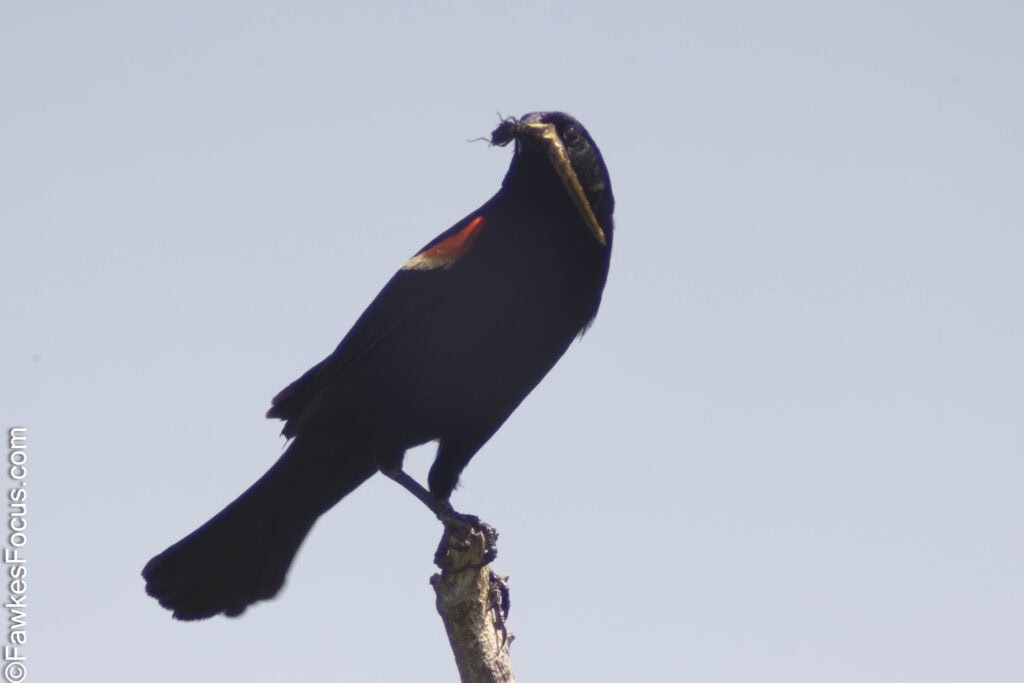
The majority of the red-winged blackbird’s diet consists of seeds, with plant materials like seeds and waste grain making up most of what they eat, while about 25% includes insects and small animals. They prefer mixed grains and seeds, often foraging in open agricultural fields during late summer and autumn.
Red-winged blackbirds feed both on the ground and in water-side habitats, searching for seeds, grains, and insects. During the fall and winter months, their diet shifts more toward grains and seeds as insects become less available.
During the breeding season, they increase their intake of insects such as:
dragonflies
moths
flies
beetles. This diverse diet consists of essential protein for their growing chicks. This diverse diet reflects their opportunistic foraging behavior and adaptability to different environments, allowing them to eat a variety of food sources, including other animals.
Songs and Calls
The distinctive song of the male red-winged blackbird, known as ‘conk-la-ree!’, is a prominent sound in wetland areas across North America. This call is often associated with territorial displays and courtship rituals, making it an integral part of their behavior. The male’s song is an abrupt note followed by a musical trill, further enhancing its role in communication and mate attraction.
Additionally, red-winged blackbirds produce various alarm calls to alert others of potential threats. These vocalizations play a crucial role in their social interactions and survival.
Backyard Tips
Drawing red-winged blackbirds to your backyard can be delightful. They are attracted to feeders offering bread, seed mixtures, and suet. High-quality seed mixes with foods like sunflower seeds can significantly increase your chances.
Place feeders at different heights and locations to mimic their natural foraging environments and encourage visits. Positioning feeders near protective cover like bushes or trees helps birds feel secure while feeding.
Cool Facts About Red Winged Blackbirds
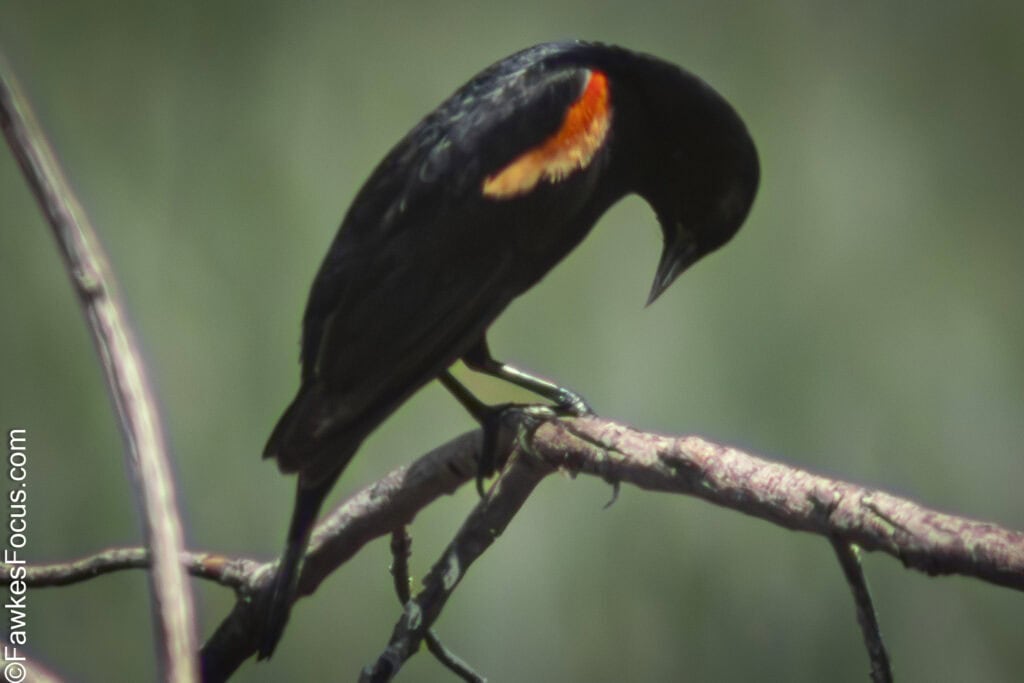
Red-winged blackbirds play a significant role in their ecosystems by interacting with various bird species. They can interpret the alarm calls of other birds, like the Yellow Warbler, to respond appropriately to threats. With a population of approximately 150 million birds, they are one of the most numerous birds in North America.
Interestingly, male red-winged blackbirds exhibit polygynous behavior, often mating with multiple females within their territory. This social structure is a fascinating aspect of their behavior, contributing to their reproductive success. Males of the species are polygynous, defending territories that house multiple nesting females, which highlights their complex social dynamics.
Conservation Topics
Despite their large population, red-winged blackbirds face several conservation challenges. Habitat destruction, climate change, and targeted control measures like poisoning and trapping threaten their numbers, leading to an attack on their population.
Conservation organizations are actively working to restore protections under the Migratory Bird Treaty Act, which offers essential protection to various bird species, including red-winged blackbirds. Ensuring these protections remain in place is crucial for their future.
Summary
In summary, red-winged blackbirds are a fascinating species with distinctive characteristics and behaviors. From their striking appearance and territorial displays to their complex social structures and adaptive habitats, these birds offer endless opportunities for observation and study.
As we continue to appreciate and protect these avian wonders, it’s essential to support conservation efforts and maintain healthy ecosystems. By understanding and valuing red-winged blackbirds, we can ensure their vibrant presence in our wetlands and fields for generations to come.
Frequently Asked Questions
How can I distinguish male and female red-winged blackbirds?
You can easily distinguish male red-winged blackbirds by their glossy black plumage and bright red and yellow shoulder patches, whereas females are streaky brown and resemble large sparrows.
What do red-winged blackbirds eat?
Red-winged blackbirds primarily eat plant materials, such as seeds and waste grains, but they also include insects and small animals in their diet, particularly during the breeding season.
Where do red-winged blackbirds prefer to nest?
Red-winged blackbirds prefer to nest in wetlands rich in tall vegetation like cattails, but they are also adaptable and can nest in drier environments and agricultural areas.
What is the migration pattern of red-winged blackbirds?
Red-winged blackbirds migrate south from northern populations to the southern U.S. and Central America for winter, generally starting their journey in September or October. This seasonal movement is crucial for their survival during colder months.
How can I attract red-winged blackbirds to my backyard?
To attract red-winged blackbirds to your backyard, set up bird feeders with bread, seed mixtures, and suet, and place them at various heights near protective cover such as bushes or trees. This will create a welcoming environment for these birds.
